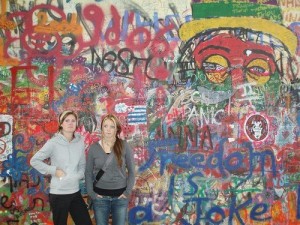This image of graffiti is one I took of my friends standing beside the John Lennon Wall in Prague. The graffiti on this wall was started in the 80’s by Czech youth who used it as a way to demonstrate free-speech (Kruse, 2005). Graffiti was used as a tool for a non-violent rebellion against the neo-Stalinism at the time (Kruse, 2005). According to Bren (2008) it is this youth who painted on this wall during the last year of communism, who became central to the Velvet Revolution. John Lennon strongly advocated freedom and peace in his music, and Kruse (2005) believes this is why the youth praised him. His lyrics were written in english which was essential to their resistance, it helped to define a boundary between them and the government ( Ferrel 1993). Lennon provided an way in which they were able to protest the government and promote the need for a peaceful change.
This wall used to be whitewashed by the authorities (Kruse, 2005) but now it only changes because of the new graffiti overlapping the previous. This graffiti is a monument for it marks how people were able to create change. The wall still has politically fuelled graffiti but a difference is a global audience can add to it. This graffiti is an example to which other politically driven graffiti strives for because it succeeded in creating a change.
Follow this link to see the variety of graffiti this wall has had.
By: Kate MacMillan
Bren, P. (2008). Mirror, Mirror, on the Wall … Is the West the Fairest of Them All?: Czechoslovak Normalization and Its (Dis)Contents. Kritika: Explorations in Russian and Eurasian History. 9(4):831-854.
Ferrel, J. (1993). The World Politics of Wall Painting. Social Justice. 20(3/4):188-202.
Kruse II, R. (2005). Contemporary Geographies of John Lennon. Critical Studies in Media Communication. 22(5):456-461

